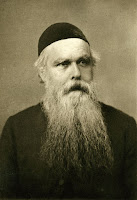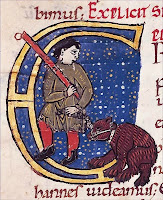 Sleep. It's a funny phenomenon -- funny in the sense of peculiar, as well as being an opportunity for levity on sitcoms. Yet sleep is also an earnest matter. It even links our lives on the evolutionary tree with other animals.
Sleep. It's a funny phenomenon -- funny in the sense of peculiar, as well as being an opportunity for levity on sitcoms. Yet sleep is also an earnest matter. It even links our lives on the evolutionary tree with other animals.We humans get introduced quite early in life to sleep's being more than meets the eye. More than one parent has had to deal with a young child's having nightmares. It is probably clearer to the parent how the disruptive dreams connect with some anxiety in the child's waking life. In other instances, the child's nightmare can be marked by that strange other-worldly feeling we can be struck by upon remembering a dream on awaking. One mother I know was told at breakfast by her pre-schooler that he had been chased by a giraffe. Fortunately, the mother, rather than reprimanding the child for lying, explained to her child that he had simply had a scary dream.
The phenomenon of sleep can also be scary to a child viewing it from the outside: I remember as a child entering my mother's bedroom when she was napping so soundly that my mind almost became overtaken by the fear that she was dead. The similarity between deep sleep and death adds another layer to the peculiarity of dreams, as well as providing material for literary pens. In a time before modern medicine's ability to measure brain waves, Edgar Allan Poe took advantage of the frightening thought that a person might be declared dead when the person was just asleep. Poe's story "The Premature Burial" is a gripping tale.
 As we journey through life, learning about the world we live in, we also discover that many other animals sleep, and mammals clearly dream. Those fishes in my childhood aquarium, sometimes hovering motionless, were probably sleeping (I was told), even though they had no eyelids to close to let me know they were sleeping. It was easier to recognize that our pet dog was dreaming when, lying on its side, its legs began running, no doubt chasing something rather than being chased.
As we journey through life, learning about the world we live in, we also discover that many other animals sleep, and mammals clearly dream. Those fishes in my childhood aquarium, sometimes hovering motionless, were probably sleeping (I was told), even though they had no eyelids to close to let me know they were sleeping. It was easier to recognize that our pet dog was dreaming when, lying on its side, its legs began running, no doubt chasing something rather than being chased.
Contemporary scientists have been able to verify that dreaming can be a means for processing the preceding day's activities, even enhancing learning. For example, a sleeping rat's brain undergoes the same activity it did when the rat was exploring a new maze the day before.
Despite sleep being essential to many animals' lives (and even to plants, in a way), the wisdom of our faith-traditions has adopted sleep as a symbol of something we should not be doing -- at least when we're awake! The Buddha's title in Sanskrit indicates that he is for Buddhists the model of "the Awakened One." As Christmas approaches, many Christians sing hymns containing reminders to stay alert, to "keep watch" like shepherds protecting their sheep.
 However, remembering that marvelous ability of babies to sometimes sleep soundly amid hubbub, we can also wish all babies in the world the gift of being able to "sleep in heavenly peace."
However, remembering that marvelous ability of babies to sometimes sleep soundly amid hubbub, we can also wish all babies in the world the gift of being able to "sleep in heavenly peace."
Do you have a wish for the world about sleep or about watchfulness?
 However, remembering that marvelous ability of babies to sometimes sleep soundly amid hubbub, we can also wish all babies in the world the gift of being able to "sleep in heavenly peace."
However, remembering that marvelous ability of babies to sometimes sleep soundly amid hubbub, we can also wish all babies in the world the gift of being able to "sleep in heavenly peace."
~~~
Do you have a wish for the world about sleep or about watchfulness?
(The quoted hymn-line is from John Freeman Young's
1863 translation of "Stille Nacht" ["Silent Night"], 1818 lyrics by Joseph Mohr.)
(The photograph of the artwork of the deer was made by Joachim Lutz,
and is used under under a Creative Commons Attribution-Share Alike 2.5 Generic license.)























![Swallows, watercolor by German painter Gustav Mützel [1839 - 1893]) Life, so fragile, yet so powerful.](https://blogger.googleusercontent.com/img/b/R29vZ2xl/AVvXsEipc0EOEvVmTwnycHV2lq60KYYbnuiS7EyhYcxRC5Qv6icQ07m2w9qKOwXwyMiepA_BSDfi0BgZf2q0vok5VJZtJ53WBHHeH7hfSm5zjzMjS8k6X0vsy4NA_EydEJX4-CmCgFzKYOk_G5o/s1600/swallows+with+nest.jpg)


![(illustration from "The Story of the Three Bears" [1900] by Leonard Leslie Brooke.) Cute in cartoons, but...](https://blogger.googleusercontent.com/img/b/R29vZ2xl/AVvXsEiBRhD7ZlMSaJ5QCR8B9SMowhcbewWTSH-Qyg0u9IAkamnQ8v6dBSfFT2BosqCr2hwR5-ag3SOrwaftx2bg-CIFnTFd2x6lK-53VOPOoftv5VCh0uuomz2Jd0erZ-uts3V6Dqs9JvL9-nM/s200/Three+bears+getting+porridge.jpg)

![(painting of Russian brown bear family by A. N. Komaro, from "Mammals of the Soviet Union" [1988] by V. G. Heptner, et al.) A life of their own.](https://blogger.googleusercontent.com/img/b/R29vZ2xl/AVvXsEime8H1eBiW4pKYUlcF_TdQd2ybuCbOpHSG_DVKwRWSf4tS1QKaR-vNxwElibO-ZB2tLlCR6HHOahx41_qOkdYf1TYBBklMVm_G9mxgzqoqNXzSSwT3I7zkioh8bR2DHXBCjPdA5-r0KzA/s200/mother+bear+and+two+cubs+by+trees.jpg)

